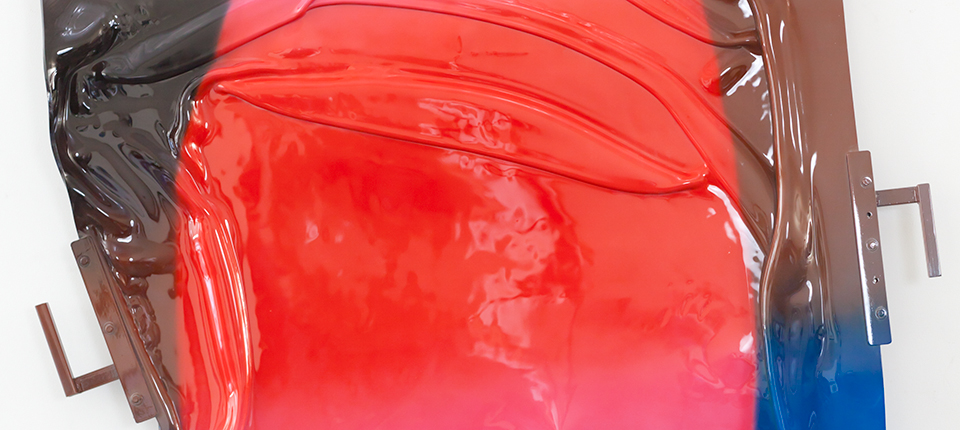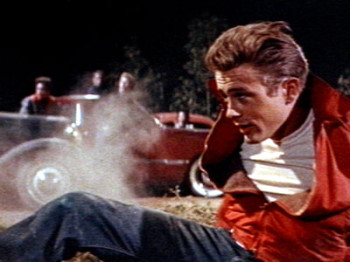Exhibition VIII
Skyler Brickley: Meltdown
Skyler Brickley’s Golden Rice is a red diptych which pairs a piece of distorted common plastic with a flat object cut to the same profile; the latter’s surface features an image of the former and framed within a perforated stainless steel panel backed by a black coated sheet. The panels of the frame reinterpret the dot—a motif that is threaded through Brickley’s previous paintings. Brickley first employed the mark in his 2008 canvases as a reference to the Benday dot, and in the current show it continues to morph.
These works evoke those of John Chamberlain, for whom the car represents the individualism and freedom that imbue the American imagination, imagery embraced during the golden era of Hollywood movies. Brickley motions further to the perversion of those fantasies and the environmental destruction wreaked by the materials that compose our modern lives. The two parts of the diptych mirror one another, configuring not only the work but the entire exhibition as a mise en abyme of self-reflexivity.
The series of works in this exhibition illuminates the rebellious character of Brickley’s challenge to painting as a bourgeois task by focusing on industrial materials including car paint. His extensive range of experimentation serves not only to negate painting but also to reinvigorate and redefine his own practice.
The series evinces a real and metaphorical cycle of social meltdown, destruction and the possibility for redemption via aesthetics. The utilization of industrial methods and materials to create the artwork holds the capitalist project uncomfortably close, so that the work criticizes but also somehow endorses modern manufacturing. Brickley’s warped shapes recalling the mangled cityscapes, bombed-out buildings and melting cars are suggestive of the violence still raging more than a decade after 9/11.
The final works operate as schematic representations of abstracted manufacturing processes, histories of the digital revolution or symbols of innovation; they also enact the familiar layering of Photoshop manipulations. As artworks that incorporate—and thus expose—the vitrine as filter, they critique didactic claims about signification.
Brickley begins his process with sheets of the common plastic PETG, which he then submits to various forms of manipulation including melting, twisting and stamping. Reversing this destructive process, the works are then chromed or painted with automotive paints, and in some cases imprinted with images transferred via screen- and flatbed printing.
By layering and distorting images, Brickley explores the concept of illusion in painting while, in an acutely expressionist gesture, incorporating a confluence of techniques and drawing attention to his method, materials and process. The final pieces’ agitated surfaces echo abstract expressionist works. Dark yet luminous, the works are ultimately uplifting, soliciting a range of emotional responses from despair to joy.
In another work, Gamay Goo, the dot appears as an indentation in PETG, serving as an analogy for the pixel and representing the shift from analog to digital. The work’s composite materials contrast the smooth, burnished finish of Masonite with chrome painted, dotted PETG. Masonite, a high-density fibreboard (HDF), was once mass-produced for applications such as desktops; here, it marks the transformation from the industrial to the digital ages.
The empty aluminium bathroom stalls, Single-Beam Gradient Force Trap, interrupts the gallery expanse, and suggests moving from the Duchamp fountain to the clean horizontal stacks of a Donald Judd installation.
Reinterpreting the dot once again, the figure is incarnated here in three-dimensional space as a hole. Each metal door functions as an abstract painting, looping back to earlier canvases in Brickley’s oeuvre.
Solid back backing behind the perforated facades of the doors obfuscates the viewer’s sight and frustrates attempts at discerning the truth of the enclosed spaces merely by looking. Then, upon entering the empty stalls, the viewer is left to reckon only with himself as his blurry image is reflected back to him on the shiny stall doors. The work first seduces the viewer then remains obstinately mysterious and withdrawn. Romantically suggesting the capacity for self-discovery in art, it offers silence amidst chaos and violence.
Skyler Brickley (b. 1976, Edmonton, Alberta) lives and works in New York. He holds an MFA from Yale School of Art (2005) and a BA from Macalester College in St. Paul (1999). In 2005, the artist attended Skowhegan School of Painting and Sculpture and, in 2010, made his New York solo debut with Marvelli Gallery. Venues in which his work has been exhibited in group shows include Mottahedan Projects in Dubai; Sandroni Rey in Los Angeles; Yvon Lambert in New York; Hudson Valley Center for Contemporary Art in Peekskill, New York; Tiger Strikes Asteroid in Philadelphia; and the Museum of Contemporary Art in Tucson, Arizona. Brickley serves as a co-founder of The Highlights (thehighlights.org), an online journal he launched in 2007 with Ethan Greenbaum and Luke Stettner in order to provide artists with an outlet for engaging in unconventional criticism; the publication seeks to serve as a platform for experimental text and digital media projects.















